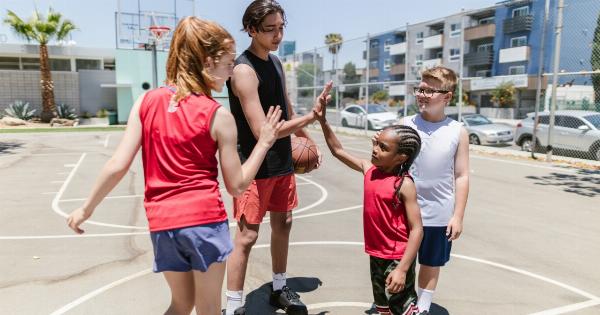Sports play a crucial role in the physical development of children. Engaging in physical activities not only helps them stay fit but also strengthens their musculoskeletal system.
The musculoskeletal system includes bones, muscles, tendons, ligaments, and joints, which work together to support movement and stability. Therefore, it is important for children to participate in sports that promote the growth and development of their musculoskeletal system.
In this article, we have compiled a list of the best 30 sports that can help strengthen children’s musculoskeletal system.
1. Swimming
Swimming is a low-impact sport that engages all major muscle groups and helps develop strong bones and joints. The resistance of water provides an excellent workout for the entire body, improving flexibility, strength, and endurance.
2. Basketball
Playing basketball involves running, jumping, and quick changes in direction. It helps develop strong leg muscles, improves hand-eye coordination, and enhances overall body strength.
3. Soccer
Soccer is a high-intensity sport that helps improve cardiovascular fitness and builds strong lower body muscles. The constant running, kicking, and passing involved in soccer contribute to the development of a robust musculoskeletal system.
4. Gymnastics
Gymnastics involves various movements that require strength, flexibility, and balance. This sport helps strengthen muscles, improve bone density, and enhance overall body coordination.
5. Tennis
Tennis requires quick sprints, powerful strokes, and lateral movements. Regular participation in tennis helps develop strong arms, legs, and core muscles, while also improving bone health.
6. Martial Arts
Martial arts not only teach self-defense but also improve flexibility, coordination, and balance. This sport helps develop strong muscles, bones, and joints, promoting overall musculoskeletal health.
7. Cycling
Cycling is a low-impact sport that strengthens leg muscles and promotes cardiovascular endurance. Regular cycling helps maintain joint mobility, improves posture, and contributes to overall fitness.
8. Wrestling
Wrestling is a physically demanding sport that builds strength, agility, and power. The intense grappling movements involved in wrestling contribute to the development of a strong musculoskeletal system.
9. Hockey
Hockey requires quick movements, coordination, and strength. Playing hockey helps develop strong leg muscles, improves balance, and enhances overall physical fitness.
10. Volleyball
Volleyball involves jumping, hitting, and constant movement. The sport strengthens leg muscles, improves hand-eye coordination, and enhances overall body stability.
11. Baseball
Baseball involves throwing, catching, and running, which engage various muscles groups. Regular participation in baseball helps develop strong arms, leg muscles, and core stability.
12. Track and Field
Track and field events such as sprinting, long jump, and javelin throw stimulate the development of strong muscles, bones, and improve overall athleticism.
13. Rugby
Rugby is a physically demanding sport that requires strength, endurance, and teamwork. The intense tackles, running, and grappling involved in rugby help develop a robust musculoskeletal system.
14. Skiing
Skiing engages major muscle groups, especially the leg muscles, and improves balance and coordination. It also helps develop strong bones due to the impact of skiing on uneven terrains.
15. Badminton
Badminton involves quick footwork, agility, and hand-eye coordination. Regular play helps develop strong leg muscles, improves reflexes, and enhances overall fitness.
16. Climbing
Climbing, whether indoor or outdoor, engages the muscles of the entire body. It helps develop core strength, improves grip strength, and enhances overall body stability.
17. Wrestling
Wrestling is a physically demanding sport that builds strength, agility, and power. The intense grappling movements involved in wrestling contribute to the development of a strong musculoskeletal system.
18. Table Tennis
Table tennis requires quick reflexes, hand-eye coordination, and constant movement. Regular play improves arm and leg muscles, enhances balance, and promotes overall fitness.
19. Dance
Dance forms like ballet, jazz, and hip-hop involve a wide range of movements that help strengthen muscles, improve flexibility, and enhance posture and balance.
20. Martial Arts
Martial arts not only teach self-defense but also improve flexibility, coordination, and balance. This sport helps develop strong muscles, bones, and joints, promoting overall musculoskeletal health.
21. Cricket
Cricket involves running, batting, and throwing, which engage various muscle groups. Regular participation in cricket helps develop strong arms, leg muscles, and core stability.
22. Golf
Golf is a sport that requires precision, coordination, and core strength. The swinging motion involved in golf helps develop strong arm muscles, promotes flexibility, and enhances overall fitness.
23. Martial Arts
Martial arts not only teach self-defense but also improve flexibility, coordination, and balance. This sport helps develop strong muscles, bones, and joints, promoting overall musculoskeletal health.
24. Skiing
Skiing engages major muscle groups, especially the leg muscles, and improves balance and coordination. It also helps develop strong bones due to the impact of skiing on uneven terrains.
25. Archery
Archery involves drawing and releasing a bowstring, which strengthens the muscles of the arms, shoulders, and back. Regular archery practice helps develop upper body strength and improves focus and concentration.
26. Rowing
Rowing is a full-body workout that engages muscles in the arms, legs, and core. It improves cardiovascular endurance, strengthens muscles, and promotes overall physical fitness.
27. Karate
Karate involves punches, kicks, and rapid movements. Regular practice helps develop strong muscles, improves flexibility, and enhances overall body coordination.
28. Lacrosse
Lacrosse requires running, catching, and throwing, which engage various muscle groups. Regular participation in lacrosse helps develop strong arms, leg muscles, and core stability.
29. Yoga
Yoga combines physical postures, breathing exercises, and meditation. Regular practice helps develop flexibility, strength, and overall body balance.
30. CrossFit
CrossFit involves a combination of high-intensity workouts that incorporate elements of weightlifting, cardiovascular exercise, and bodyweight movements. It helps develop strength, endurance, and overall fitness.































